|
||||
| Til kurven | ||||
|
||||
| Til kurven | ||||
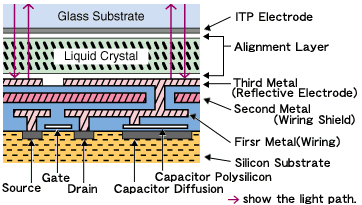 The D-ILA® (Digital Direct
Drive Image Light Amplifier) technology that JVC has
developed is based on an innovation in microchip design
that permits the viewer to enjoy the full range of
benefits from any high quality source whether from a
video deck or a computer device. For true HDTV
performance, the D-ILA® technology packs 2048
x 1536 pixels -a total of 3.2 million pixels- on a
single 1.3" chip. This makes possible display of HD
images at full-spec resolution of 1920 x 1080 -with room
to spare.
The D-ILA® (Digital Direct
Drive Image Light Amplifier) technology that JVC has
developed is based on an innovation in microchip design
that permits the viewer to enjoy the full range of
benefits from any high quality source whether from a
video deck or a computer device. For true HDTV
performance, the D-ILA® technology packs 2048
x 1536 pixels -a total of 3.2 million pixels- on a
single 1.3" chip. This makes possible display of HD
images at full-spec resolution of 1920 x 1080 -with room
to spare.The D-ILA®'s innovative CMOS design is the key to reproducing all the details in a high-definition picture. By placing the matrix addressing switches and electronics right behind (not between) the light-modulating liquid crystal layer, JVC has created a D-ILA® chip with a "3-dimensional" layout. The result is a 93% fill factor and virtual elimination of the annoying "grid" or "screen door effect" so evident in other fixed matrix display technologies. What is the end result? Images as smooth and natural as film with impeccable reproduction of all the details and information contained in the original source. What supports this high picture quality is high brightness, high resolution, high contrast and analog gradation. High brightness and high resolution are achieved using a reflective device with a high aperture ratio and high-density pixels, providing real resolution with invisible pixels. High contrast is achieved using vertical alignment liquid crystals of normally black operation and a high-precision optical system. Analog gradation makes it possible to reproduce dark areas with high S/N (signal-to-noise ratio) because the D-ILA® device has an S-shape response. In combination with the high-speed response of the vertical alignment liquid crystal, JVC's D-ILA® technology makes it possible to reproduce smooth, noiseless motion pictures with clear, sharp high definition and film-like picture quality. |
|
The secret behind the exquisite, film-like picture quality with 15,000 - 20,000:1 native contrast ratio lies in the innovative D-ILA® device technology, the optical engine and the fact the JVC DLA-HD1 or DreamBee projector does not rely on iris control. Conventional front projectors use an iris control to boost contrast ratio. With such projectors, picture resolution may be excellent, but the picture lacks good contrast. Here you can see the difference between a conventional projector with iris control and JVC DLA-HD1 or DreamBee.
|
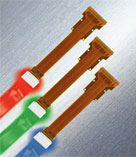 Conventional D-ILA® devices suffer from surface unevenness,
minute gaps and irregularities that are unavoidable using normal
semiconductor manufacturing processes. Discontinuities between
individual pixel cells or where the pixel cells are connected
with the underlying semiconductor structure disturb the
orientation of the liquid crystals, and the resulting
diffraction and other effects lead to stray light. In the
manufacture of this newly developed device, technology has been
adopted to ensure extreme planarization; this reduces to an
absolute minimum such stray light.
Conventional D-ILA® devices suffer from surface unevenness,
minute gaps and irregularities that are unavoidable using normal
semiconductor manufacturing processes. Discontinuities between
individual pixel cells or where the pixel cells are connected
with the underlying semiconductor structure disturb the
orientation of the liquid crystals, and the resulting
diffraction and other effects lead to stray light. In the
manufacture of this newly developed device, technology has been
adopted to ensure extreme planarization; this reduces to an
absolute minimum such stray light.Moreover, as a result of employing new liquid crystal materials and orientation technologies, the gap between pixel cells has been optimised, reducing it from the previous 3.2 microns to 2.3 microns, cutting light loss from the liquid crystal layer itself, and significantly improving compensation accuracy. Such new technologies have realized the extremely high device contrast ratio of 20,000:1, and at the same time halved response time from 8msec (Tr+Td) to 4msec. 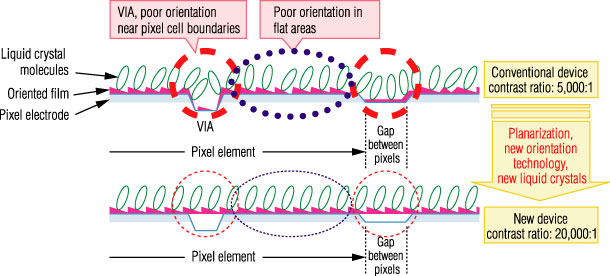 |
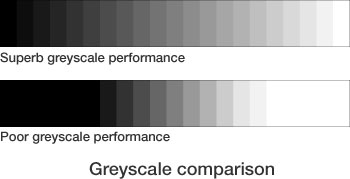 JVC original D-ILA® pulse drive produces clear,
high-precision gradations without employing error diffusion.
High-precision calibration technology enables the faithful reproduction
of dark pictures, in which luminance is 10% or less, so that the blacks
can still be differentiated, thus resulting in pictures with appreciable
texture.
JVC original D-ILA® pulse drive produces clear,
high-precision gradations without employing error diffusion.
High-precision calibration technology enables the faithful reproduction
of dark pictures, in which luminance is 10% or less, so that the blacks
can still be differentiated, thus resulting in pictures with appreciable
texture.
|
|
Using a conventional PBS (Polarizing Beam Splitter),
comprised of a glass prism with multilayer interference film, optical
properties can vary considerably depending on the angle of the incident
light beam; this makes it difficult to realise high contrast. However, the wire grid design employed for JVC newly developed optical engine uses an inorganic reflective polarizing plate made from a glass substrate on the surface of which are ultra-fine aluminium ribs. This reduces to an absolute minimum the amount of stray light reaching the lens. The combination of this polarizer with the newly developed D-ILA® device increases contrast by a factor of 5. 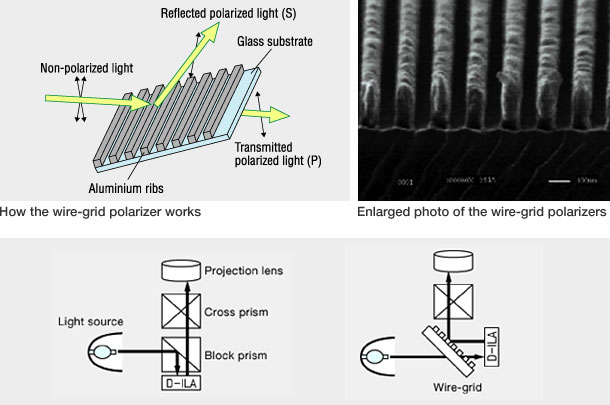 |
The
GF9351 video processor made by Gennum Corporation ensures the faithful
reproduction of high-quality images thanks to a high-precision scaling
function and four VXP™ technologies -- FineEdge™, FidelityEngine™,
TruMotionHD and RealityExpansion™.

Four VXP™ Technologies:
* VXP and Visual Excellence Processing are trademarks of Gennum Corporation. |
AV-Connection A/S • CVR nr.: DK27907547 • Kærvej 71-73 • 6400 Sønderborg • Danmark • Tlf. 7442 1078 • E-mail: [email protected]